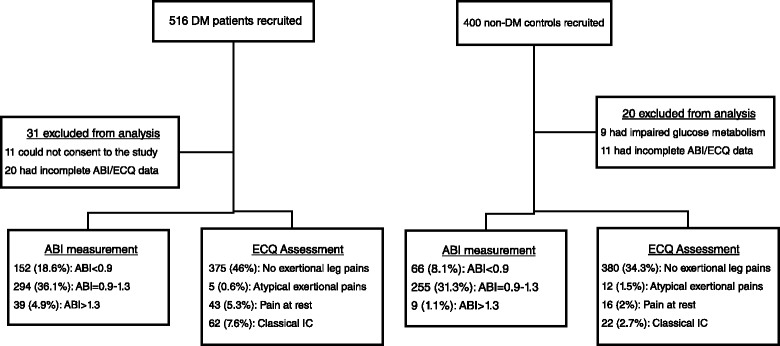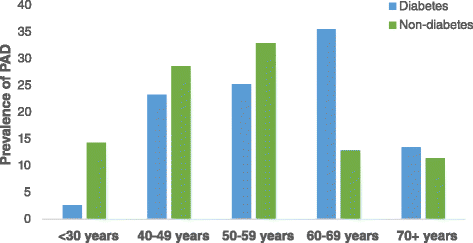Peripheral artery disease and exertional leg symptoms in diabetes patients in Ghana
- PMID: 27093857
- PMCID: PMC4837554
- DOI: 10.1186/s12872-016-0247-x
Peripheral artery disease and exertional leg symptoms in diabetes patients in Ghana
Abstract
Background: Peripheral arterial disease (PAD) is a major health problem in diabetes patients in high-income countries, but the PAD burden in sub-Saharan Africa is largely undetermined. We studied the prevalence of PAD and exertional leg symptoms in diabetes (DM) patients in a tertiary hospital in Ghana.
Methods: In a case control study design, 485 DM and 330 non-diabetes participants were recruited. PAD was diagnosed as Ankle Brachial Index (ABI) < 0.9. Edinburgh Claudication Questionnaire (ECQ) was used to assess exertional leg symptoms.
Results: The overall prevalence of classical intermittent claudication was 10.3 % and ABI-diagnosed PAD was 26.7 %, with 3.5 % of the participants having both classic intermittent claudication and ABI-diagnosed PAD. The prevalence of exertional leg symptoms were similar in diabetes patients with and without PAD. In non-diabetes participants, intermittent claudication and rest pain were higher in PAD patients than in non-PAD participants. In multivariable logistic regression, intermittent claudication [OR (95 % CI), 3.39 (1.14 - 8.1), p < 0.05] and rest pain [4.3 (1.58 - 9.67), p < 0.001] were independently associated with PAD in non-diabetes group, and rest pain [1.71 (1.13 - 2.17), p < 0.05] was associated with PAD in all participants.
Conclusions: There is high burden of PAD and exertional leg pains in DM patients in Ghana. PAD is expressed as intermittent claudication and rest pain in non-diabetes individuals.
Keywords: Ankle brachial index; Diabetes; Exertional leg symptoms; Ghana; Peripheral arterial disease.
Figures




References
-
- Fowkes FGR, Rudan D, Rudan I, Aboyans V, Denenberg JO, McDermott MM, Norman PE, Sampson UK, Williams LJ, Mensah GA. Comparison of global estimates of prevalence and risk factors for peripheral artery disease in 2000 and 2010: a systematic review and analysis. Lancet. 2013;382(9901):1329–40. - PubMed
-
- Amoah A. Hypertension in Ghana: a cross-sectional community prevalence study in greater Accra. Ethn Dis. 2002;13(3):310–5. - PubMed
MeSH terms
Grants and funding
LinkOut - more resources
Full Text Sources
Other Literature Sources
Medical

